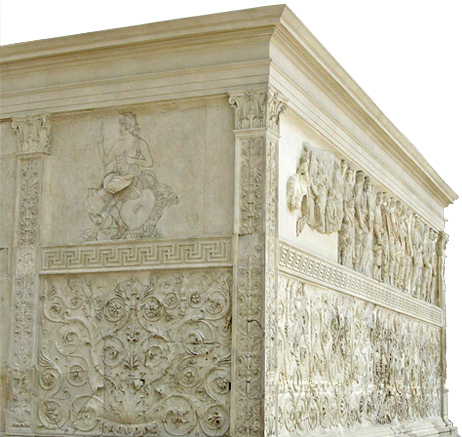
You turn and walk around the north enclosure wall, where you look up at the stately procession of near life-size senators and priests, draped in togas and wearing laurel wreaths on their heads, walking toward the west, commemorating the original dedication ceremony and sacrifice. Among the priests is a camillus, a youthful attendant at sacrifices, carrying the ritual implements of his office, such as a pitcher (urceus), carved incense-box (acerra), and the fringed mantele. Behind these walk members of the imperial family, including children, and you realize that this was the first time that children were depicted in public monuments other than funerary altars and tombstones. You are touched by the little barbarian boy, no more than a toddler, clutching a man's toga and looking up at him trustingly. You think he must represent the child of a Gallic chieftain given to Augustus as a Roman hostage, symbolizing his pacification of that province.
At the end of this procession are two women wearing fringed cloaks (ricinia) often worn by windows, whom you think might be Augustus's daughter Julia, widow of Agrippa, and his sister Octavia, widow of Mark Antony. Between them walks a young boy, probably Julia's son Gaius Caesar, adopted by Augustus. He is dressed unusually, without the bulla and toga praetexta worn by other Roman children on the monument, wearing only a belted tunic with a fringed cloak thrown over his left shoulder. You wonder whether this cloak might be the military paludamentum (such as worn by Octavian on this equestrian statue), indicating the early military prominence Augustus gave to his adopted son. Behind Gaius is a younger girl, wearing a toga praetexta, earrings, and a lovely necklace with hanging pendants (as worn by Venus on a denarius of Octavian); her hair is carefully arranged in a melon coiffure. The man behind her rests his hand protectively on her head. You think she may be Julia, younger sister of Gaius.
The lower zones on all the enclosure walls feature intricately carved vegetation, with scrolling tendrils of acanthus spiraling upward from a single central plant, topped by Apollo's swans spreading their wings. Looking more closely, you smile as you spy a snake slithering toward a nest of baby birds, while above a lizard basks on a broad acanthus leaf.